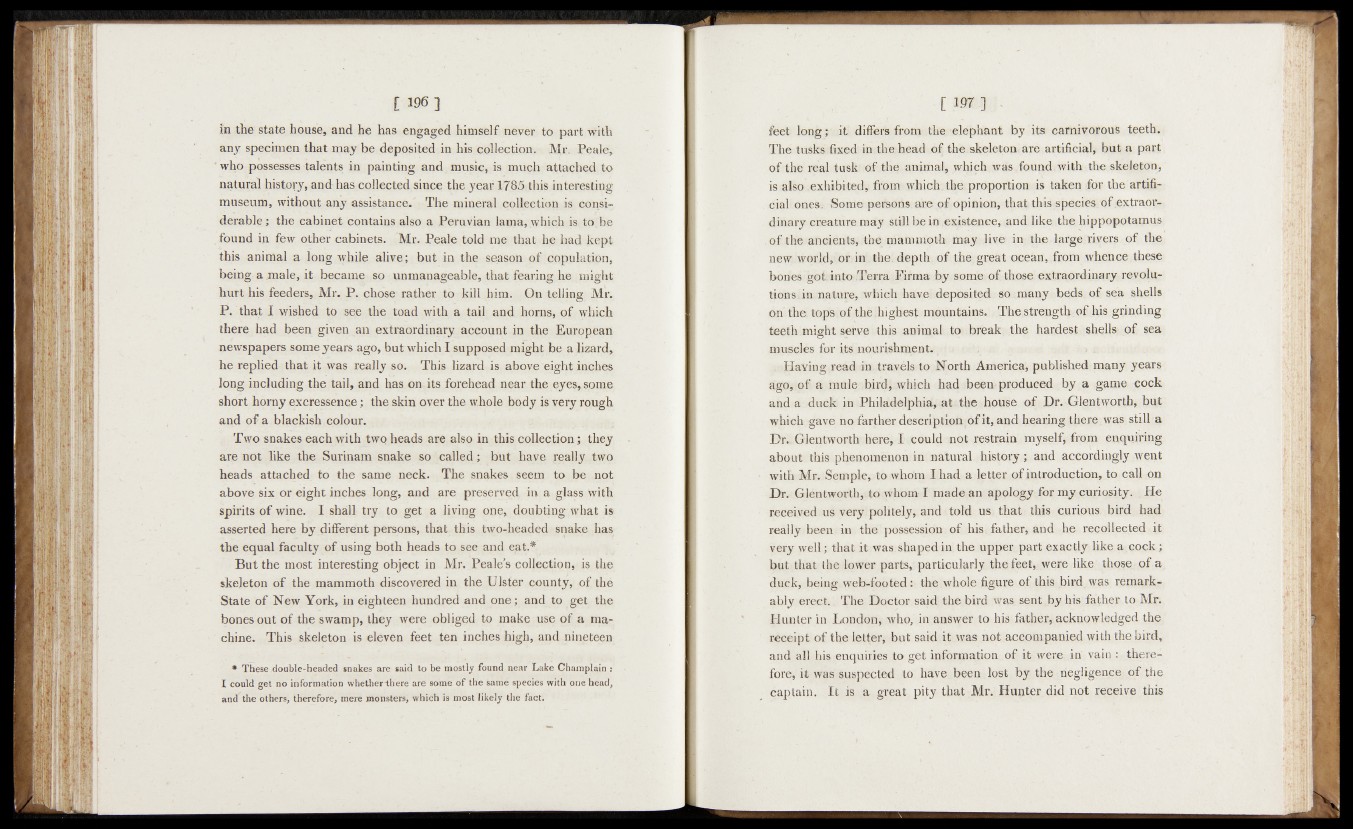
in the state house, and he has engaged himself never to part with
any specimen that may be deposited in his collection. • Mr. Peale,
who possesses talents in painting and music, is much attached to
natural history, and has collected since the year 1785,this interesting
museum, without any assistance*^ The mineral collection is considerable
; the cabinet contains also a Peruvian lama, which is-- tö jse
found in few other cabinets. Mr. Peale told me that he had kept
this animal a long while alive; but in the season of copulation,
being a male, it became so unmanageable, that fearing he might
hurt his feeders, Mr. P. chose rather tó kill him. On telling Mr.
P. that I wished to sec the toad with a tail and horns, of which
there had been given an extraordinary account in the European
newspapers some years ago, but which I supposed might be a lizard,
he replied that it was really so. This lizard is above eight inches
long including the tail, and has on Jts forehead near the eyes, some
short horny excressence; the skin over the whole body is very rough
and of a blackish colour.
Two snakes each with twq heads are also in this collection; .they
are not like the Surinam snake so -called; but have really..two
heads attached to the same neck. The snakes seem to be not
above six or eight inches long, and are preserved, in; a glass with
spirits of wine. I shall try to get a Jiving one, doubting what is>
asserted here by different persons, that this two-headed snake has
the equal faculty of using both heads to see and eat.*
But the most interesting object in Mr. Pealed collection, is the
skeleton of the mammoth discovered in the Ulster county, of thé
State of New York, in eighteen hundred and one ; and to get the
bones out of the swamp, they were obliged to make use of a machine.
This skeleton is eleven feet ten inches high, and nineteen
* These .dooble-headed snakes are. said to be mostly found near Lake Champlain >
I could get no information whetherthere are some o f the same species with one head,
and'the others, therefore, mere monsters, which is most likely the fact.
feet long; it differs from the elephant by its carnivorous teeth.
The tusksifixed: in.the/head of the.skeleton! are artificial, but a part
of the real itusteMfthd animal, which was.found;with the skeleton,
is also .exhibited,; from which.the, proportion* is taken for the artificial
ones-.,-Some persons are pfopinion, that this species Qfiextraor-r;
dinary creature.may still be in existence, ;,and, like the hippopotamus
of the a fi dents,, the mammoth may livd in^ihe large;ri.vers of the
new. world, or in the! depth of the. great ocean, from whence . these
bonresijprtirotoTerra p frn a by somejofthqso extraQrdinary-reyolu-
tions;in.nature, which;have!,deposited saimanycbqds of sea shells
on thei topsuof thêjhighest mountains. The.strengtijsqf ;his grinding
teeth might serve this animal to.-.breaks the hardest/»sheli^pf sea
muscles for its nourishment.
> Haying read in. travels to North America, published many years
ago, of a mule bird, which had been-produced by a game cock
and a duck in Philadelphia, atj.the..-house ©f Dr. Glentwortb, but
which gave no farther description of it, and hea ringijjiqiie was still a
Dr-Glentworth here, I could not restrain myselbfróm enquiring
about this phenomenon in natural history; and accordingly ;went
with Mr. -Semple, to whdm I liad a letter of introduction,.to call (qn
Dr. Glentworth, to.whoin I made an apology^ for my curiosity. ^He
received us very politely, and told us, that this - Quri.ems, bird had
really been in the possession of his4 father, and die-, recollected it
very well; that it was shaped in, the upper part exactly- Mke,aiC.ock;
but that the iqwer parts,, particularly the feet,, were^ike those.. of a .
duck, being web-footêd c the whole figure q^ this>bird, was remarkably
erect.. The Doctor said the bird was septjay his; father. to-M?.
Hunter in London, who, in answer to his father, acknowledged .the,
receipt of the letter, but said itwas not;.accpp>panied with the bird,
and all his enquiries to. get information, of it were, in< vain : therefore,
it was suspected to have^been^lost^by the ;riegligenq%pf the
captain. It is a great pity that Mr. Hupter.did.riot jCeeive this